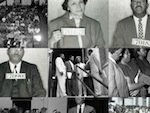In her article “Adolescents’ Perspectives on Racial Diversity in U.S. History: Case Studies from an Urban Classroom,” Terrie Epstein looks at how different racial groups are incorporated into historical narratives about the American past. She describes interpretations that address the “great paradox” where both democratic ideals and gross inequalities coexist, and asks, how do students make sense of this story? How, she asked in this study, do student views about race shape the way they understand the historical experiences of racial groups?
Epstein, a professor in the School of Education at Hunter College in New York, analyzed the end-of-year historical narratives of ten 11th graders—five African Americans and five European Americans. She was interested specifically in students’ explanations of three components: racial groups’ experiences, the government role in shaping these experiences, and the existence of a common national history or identity.
She asked each of the students to select the 20 most important historical actors and events from a set of 51 captioned picture cards and explain their choices. What Epstein found was that adolescents’ own racialized identities significantly influenced how they understood history. White students and African American students generally understood the historical experiences of racial groups through distinct historical narratives—one of expanding freedoms, and the other of ongoing racial inequality.
Expanding Freedoms Narrative
Epstein found that white students generally told positive stories about a nation shaped by those of European descent—a nation that from its inception represented the principles of individual rights and democratic rule. When explaining events directly related to African Americans, Indians, and women, students recognized that these group’s members lacked fundamental rights. Nevertheless, each student constructed a national history and identity in which all Americans shared birthrights to democratic rights and protections and these rights had expanded over time.
Ongoing Racial Inequality Narrative
African American students tended to create stories of American history characterized not by expanding freedoms, but by relations of racial domination and subordination. African Americans were at the center of their stories, fighting for freedom and equality; white historical figures, on the other hand, were significant as oppressors or as allies in that struggle. Overall, these students constructed a distinct historical narrative in which democratic principles and practices only applied to whites and racial oppression marked the experiences of African Americans, Indians, and Japanese Americans.
Working towards Synthesis
How might history teachers begin to think about synthesizing the seemingly contradictory historical themes of expanding democracy and ongoing racial inequality? Epstein suggests that history teachers help students understand that particular forms of democracy and racial inequality existed in every historical period. She concludes that discussions of the indivisible legacies of democracy and racial hierarchy might enable young people to construct narratives in which the racialized extensions and exclusions of democracy marked all Americans’ experiences and perspectives.



